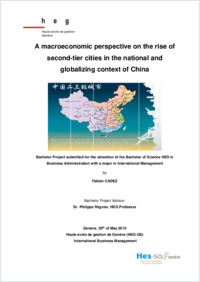A macroeconomic perspective on the rise of second-tier cities in the national and globalizing context of China
SONAR|HES-SO
- Cadez, Fabien
- Cadez, Fabien (Degree supervisor)
-
2015
62 p.
Mémoire de bachelor: Haute école de gestion de Genève, 2015
English
Since China’s economic reforms in the late 1970s, foreign investments have initially flooded the so-called “first-tier cities” including Shanghai, Beijing, or even Shenzhen or Guangzhou. Due to rising labour costs, growing constraints over natural resources, long-term inflation and environmental issues among others (Zhuang et al. 2012; Zuojun, 2012), they have been undertaking structural economic adjustments in order to shift from a “late-developing advantage” to a “first-mover advantage” model. This requires concentrating resources on modern services industry, strategic emerging industries and entrepreneurship rather than relying on foreign investments for technology, management skills and know-how (Liu, 2015). This process of economic restructuring and upgrading has initiated industrial relocation into the hinterland. As a consequence, several cities have emerged as new engines of economic growth in the past decade: Many second-tier cities have several millions inhabitants, the most performing achieved above 15% economic growth over the past decade, and many of them have been benefiting from massive public investments and preferential policies in order to accelerate their development path (China Briefing, 2010). Yet, the definition of a second-tier city is highly contextual and rather depends on the geographical scale we look at it. Therefore, this innovative research paper proposes to study the rise of second-tier cites in the national and globalizing context of China. In the national context, we undertake a comparative macroeconomic analysis between first-tier and second-tier cities in order to understand if the general environment is conducive to business investments. In the globalizing context, we focus our attention on the rise of secondary cities in Yangtze River Delta, a large emerging global city-region. More precisely, we study how Shanghai has become an urban vector for FDI into secondary cities, and thus stimulating their economic development by promoting industrial restructuring, upgrading and relocation. Ultimately, we conclude that the socio-economic development of second-tier cities are led by the first-tier city, which together benefit the overall sustainable development of China. In such a fast-changing and highly competitive business environment, second-tier cities shall be fully integrated to the strategic expansion plan of companies operating in China. Whether to achieve competiveness and cost optimization to better serve international markets or to increase revenue by supplying goods or services to Chinese consumers, decision makers shall take active anticipation and think ahead, so that the company can stand out in the market very rapidly.
- Language
-
- English
- Classification
- Economics
- Notes
-
- Travail de bachelor réalisé en vue de l'obtention du bachelor HES à la Haute école de gestion de Genève (HEG-GE), Filière économie d'entreprise, orientation International management, 2015
- Haute école de gestion Genève
- Economie d'entreprise
- hesso:hegge
- License
- License undefined
- Identifiers
-
- RERO DOC 258575
- RERO R008353444
- Persistent URL
- https://folia.unifr.ch/global/documents/314810
Statistics
Document views: 145
File downloads:
- TDEE_Cadez_Fabien.pdf: 122
